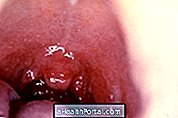Mucormycosis is an infectious disease caused by the fungus Rhizopus spp., which can be found naturally in the environment, mainly in vegetation, soil, fruits and in decomposing products, which can lead to the appearance of symptoms after spores of this fungus are inhaled.
Symptoms of mucormycosis are more frequent in people who have a more compromised immune system, with headache, fever, discharge from the eyes and nose, redness in the face and, in the most severe cases in which the fungus reaches the brain, can be noticed. there may also be seizures and loss of consciousness.
The diagnosis of mucormycosis is made by a general practitioner or infectious disease through computed tomography and fungal culture and treatment is usually done with the use of injectable or oral antifungal drugs, such as Amphotericin B.

Mucormycosis symptoms
The symptoms of mucormycosis can vary according to the general state of the person's immune system and the organ that was hit by the fungus, this is because the fungus after inhalation may be restricted to the nose or move to other organs, such as eyes, lungs, skin and brain. In general, the main signs and symptoms of mucormycosis are:
- Stuffy nose;
- Pain in the cheekbones;
- Loss of cartilage from the nose, in the most severe cases;
- Greenish nasal discharge;
- Difficulty seeing and swelling in the eyes, when there is ocular involvement;
- Cough with phlegm or blood;
- Chest pain;
- Difficulty breathing;
- Seizure;
- Loss of consciousness;
- Difficulty speaking.
In addition, when the fungus reaches the skin, reddish, hardened, swollen, painful lesions may appear and, in some situations, may become blisters and form open, black-looking wounds.
In more advanced cases, the person with mucormycosis may have a bluish tinge on the skin and purple fingers and this is due to the lack of oxygen caused by the accumulation of fungi in the lungs. In addition, if the infection is not identified and treated, the fungus can spread quickly to other organs, especially if the person has a very compromised immune system, reaching the kidneys and heart and putting the person's life at risk.
Types of mucormycosis
Mucormycosis can be divided into several types according to the location of the fungal infection, and can be:
- Rhinocerebral mucormycosis, which is the most common form of the disease in which the fungus reaches the nose, sinuses, eyes and mouth;
- Pulmonary mucormycosis, in which fungi reach the lungs, this being the second most common manifestation;
- Cutaneous mucormycosis, which consists of the spread of fungal infection in parts of the skin, which can even reach the muscles;
- Gastrointestinal mucormycosis, in which the fungus reaches the gastrointestinal tract.
There is also a type of mucormycosis, called disseminated, which is more rare and occurs when fungi migrate to various organs in the body, such as the heart, kidneys and brain.

Who is most at risk
The fungus responsible for mucormycosis can be found naturally in the environment and can be easily fought by the immune system. However, when there are changes in the immune system, there is a greater risk of developing the signs and symptoms of infection.
Thus, mucormycosis can happen more easily in people with decompensated diabetes, with HIV, who use immunosuppressive drugs or who have undergone transplants, for example.
How the diagnosis is made
The diagnosis of mucormycosis is made by the general practitioner or infectious disease by assessing the person's health history and computed tomography, which serves to verify the location and extent of the infection. Sputum culture is also performed, which is based on analyzing lung secretions to identify the infection-related fungus.
In some cases, the doctor may also request a molecular examination, such as PCR, to identify the species of fungus and, depending on the technique used, the amount present in the organism, and magnetic resonance imaging to investigate whether the mucormycosis has reached the structures of the brain, for example. These tests should be done as soon as possible, because the faster the diagnosis is made, the more chances are there to eliminate the infection.
Treatment of mucormycosis
The treatment for mucormycosis should be done quickly, as soon as the disease is diagnosed, so that the chances of cure are greater and should be done according to the doctor's recommendation, and the use of antifungals directly in the vein, such as Amphotericin, may be indicated. B, or Posaconazole, for example. It is important that the medicines are used according to the medical recommendation and that the treatment is stopped even if there are no more symptoms.
In addition, depending on the severity of the infection, the doctor may recommend performing surgery to remove the necrotic tissue caused by the fungus, which is called debridement.
Was this information helpful?
Yes No
Your opinion is important! Write here how we can improve our text:
Any questions? Click here to be answered.
Email in which you want to receive a reply:
Check the confirmation email we sent you.
Your name:
Reason for visit:
--- Choose your reason --- DiseaseLive betterHelp another personGain knowledge
Are you a health professional?
NoMedicalPharmaceuticalsNurseNutritionistBiomedicalPhysiotherapistBeauticianOther
Bibliography
- NATIONAL ORGANIZATION FOR RARE DISORDERS. Mucormycosis. Available in: . Accessed on 10 Jan 2020
- SEVERO, Cecília B .; GUAZZELLI, Luciana S .; SEVERO, Luiz C. Zygomycosis. J. bras. pneumol. Vol.36, n.1. 134-141, 2010
- IBRAHIM, Ashraf S. et al. Pathogenesis of Mucormycosis. Clin Infect Dis. Vol.24 (Suppl 1). S16-S22, 2012
- SKIADA, A. et al. Challenges in the diagnosis and treatment of mucormycosis. Med Mycol. Vol.56. 93-101, 2018
- LONGO, Dan L. et al .. Harrison Internal Medicine. 18.ed. São Paulo: AMGH Editora, 2013. 1661-1664.



















